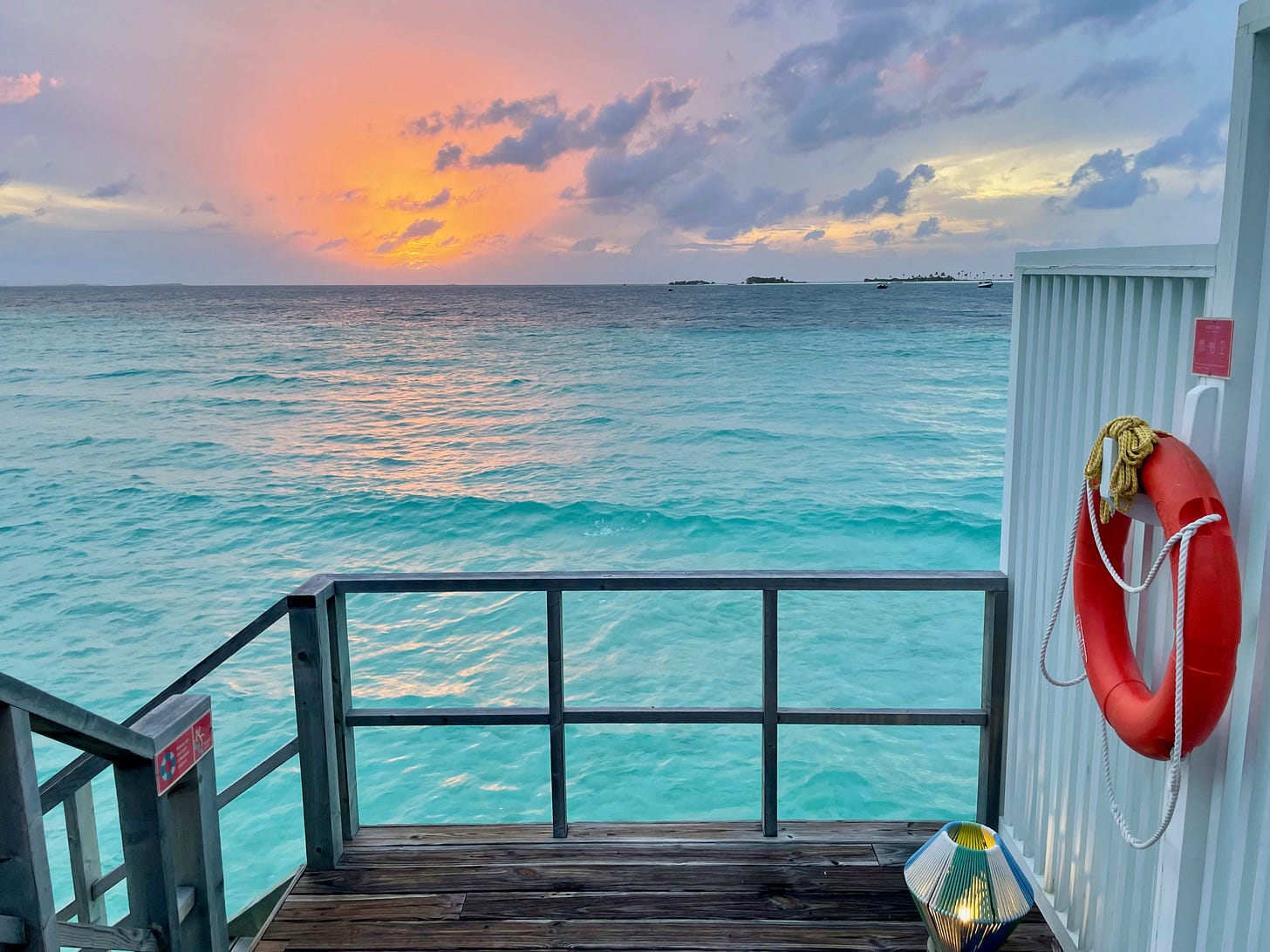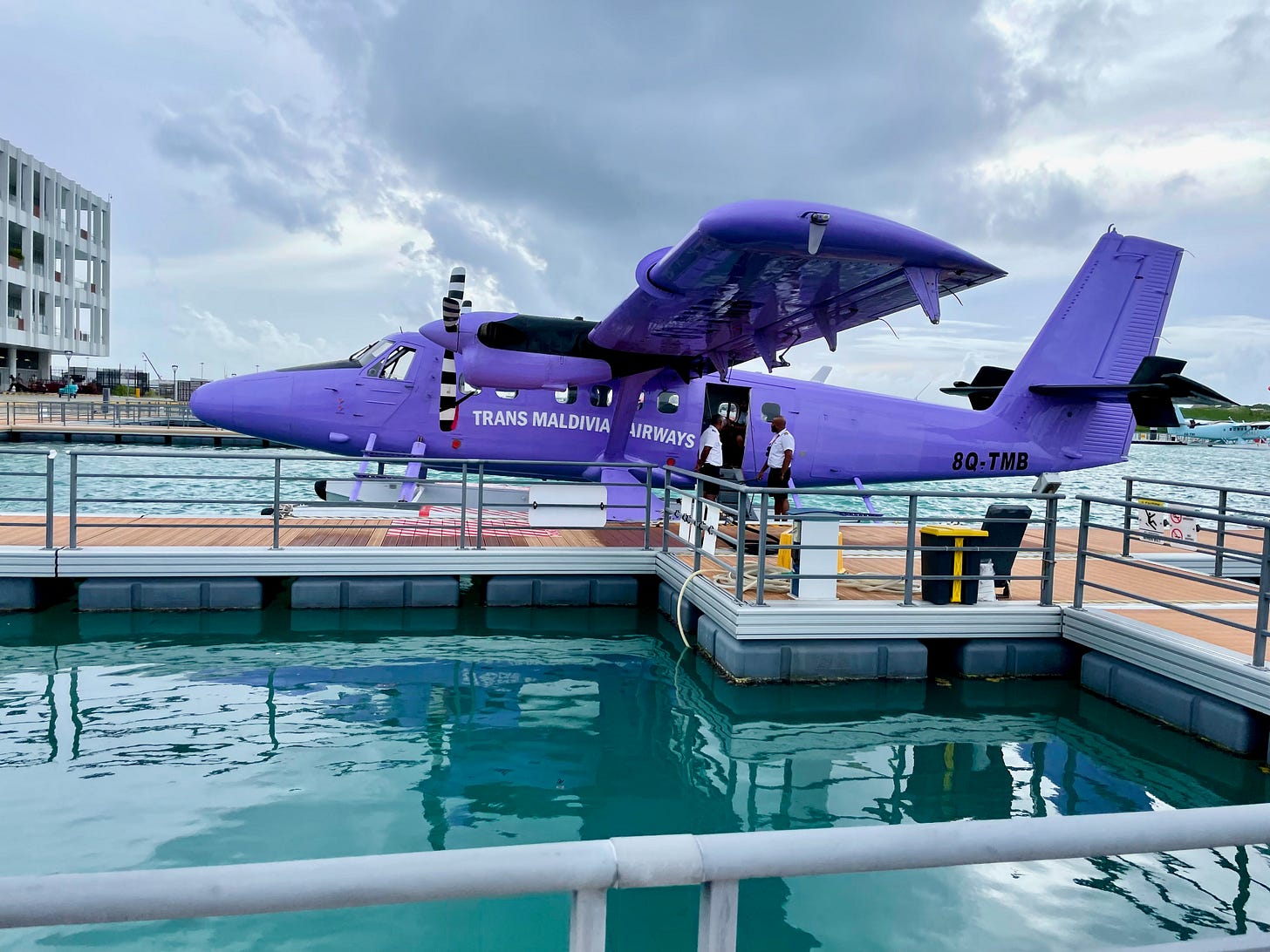I am a person who likes city getaways: sightseeing, people watching, trying new bars and restaurants. But after nine months in Cairo, which is altogether too much city, I’ve developed an appreciation for the resort vacation. I just want to show up somewhere beautiful where I don’t feel compelled to see or do anything in particular. And there’s no better place for doing nothing in particular than the Maldives, an island nation in the Indian Ocean where Nick and I just spent a week. The resort was a small private island accessible only by sea plane (as is typical in the Maldives), so there was nowhere to go but the beach. Our agenda consisted of little other than lounging in the sand and wading in warm water all day, every day.
We stayed in an over water villa, which had a back deck and a wooden staircase leading straight into a lagoon. Each morning we got up to watch the sun rise over the ocean while sipping coffee. Each night we fell asleep to the sound of the waves. And whenever I got a chance, I would lean over the rails of our deck to watch fish and baby sharks swim by. For the first time in years, I was able to completely turn off my brain and focus only on the beauty in front of me.
We visited in early August, the middle of the monsoon season, and I was nervous it would storm all week. But my fears were unfounded. We had a few days of high winds, some short flashes of tropical rain, and plenty of sun. It was the best of both worlds: mostly gorgeous weather and a half-empty resort that let us luxuriate in quiet nature.
The Maldives is famous for abundant marine life. We snorkeled with dozens of manta rays whose wingspans were up to 10 feet! They do somersaults when they feed to scoop up as many plankton as possible, making mealtime look like a graceful dance. Mantas don’t have stingers and are harmless, but it was still unnerving when they swam toward us with wide-open mouths that we could easily fit inside!
The wildlife on land was just as enchanting. We spent hours tracking down fruit bats to get photos of their sweet faces, but I was most captivated by the scores of hermit crabs zooming all over the sand. They are very social, and we found colonies in all the shady, protected spots, like under beach chairs and in trees and bushes. The hermit crabs in the Maldives have the most ornate shells—like these, which we combed for, examined, and then left on the beach for the next generation of crustacean residents.
Exclusivity, glamor, and over-the-top extravagance are the selling points for many Maldives resorts, but ours, Finolhu Baa Atoll, took a more laid-back approach. It had a fun, casual vibe, a place to relax without airs or pretension. Some guests didn’t even wear shoes to dine in the restaurant since it was right on the beach!
As earth’s flattest and lowest-lying country, the Maldives’ very existence is jeopardized by rising seas. Combatting climate change is not just an abstract matter of ethics for Maldivians, it’s a matter of survival. Accordingly, Finolhu has an impressive sustainability program and serves locally caught fish and vegetables grown on the island, resulting in surprisingly fresh food.
I typically hate all-you-can eat buffets. I find them to be chaotic places with subpar food. But after this, I might be a convert. Each meal we had at the buffet was delicious. There was one dish I made a beeline for at every single breakfast: the peppers on my plate above, which had a slight kick and were stuffed with thick, ever-so-slightly sweet cream cheese. I am obsessed with finding these peppers—I think they may have been sweet pimentos?—and recreating that perfect mix of savory, sweet, and spicy. I’ll be sure to share if I succeed, but so far none of the recipes I’ve found seem quite right. (Tell me if you have leads!)
I was happy to not have to think the whole week. Still, I would have enjoyed learning a bit about Maldivian culture and society, and being sequestered in a resort wasn’t conducive to that. So Nick and I did a bit of research. Here are some interesting facts we came up with:
The Maldivian government recently created an artificial island to alleviate overcrowding in the capital, Malé, where rising seas are eroding the land. Hulhumalé, as the new island was christened, was constructed using about six million cubic meters of sand drawn up from the seabed.
Dhivehi, the Maldivian language, only has about 300,000 native speakers, and the dialects of the Northern and Southern atolls are not necessarily mutually intelligible. Dhivehi has its own script, Thaana, whose letters are actually derived from numerals—some from Arabic, and some from a local Indic script that is no longer used.
A resort manager told us about growing up in the Maldives before it was a well-connected tourist destination. He recalled traveling to his mother’s home island via sailboat in the 90s, sometimes waiting up to two days in the middle of the ocean for a decent wind.
China and India are currently competing for influence in the Maldives because it straddles important shipping lanes. Historically, the Maldives has been in India’s sphere, but China has made major infrastructure investments in a bid to win political sway.
As the Maldives is a conservative Muslim country, alcohol is only served at resorts that cater to foreigners. Maldivian citizens are prohibited from drinking, and you can be fined for trying to bring alcohol in with you.
With Labor Day approaching, I think the Maldives was our last chance to hit the beach this season! Did you take any trips this summer? I’d love to hear about them!
Two last things before I sign off. First, I want to draw your attention to the fact that it has been 10 years since Austin Tice—journalist, Marine veteran, and my former photography classmate—was abducted while covering the early days of the Syrian civil war. I didn’t have time to get to know Austin well before he disappeared, but he was good company in the darkroom and I think of him often. Austin wanted to be among people who understood there are things worth dying for, and he put his own safety aside to tell their stories. Please keep him and his family in your thoughts.
And finally, a follow-up to last week’s newsletter on the illegal trade for artifacts! I got an interesting email from a reader—a former diplomat who served in pre-revolution Tehran—who told me about how antiquities counterfeiters faked 3000+ year old figurines called Luristan bronzes:
Several years ago a few Iranians used several originals as models to fabricate molds for casting replicas. They were highly attentive to detail. They obtained metallurgical analysis of the originals, and then arranged to manufacture bronze ingots of identical composition as the originals. They managed to duplicate the originals in virtually identical detail.
But the question was how to reduplicate the distinctive patina of oxidation. They managed to do so by obtaining analysis of soils of Luristan at sites where the bronzes were discovered. They shipped a volume of such soils to Tehran in oil drums, which they hid away in warehouses. They then manufactured compounds of the soil chemicals that produced the patina, they buried the newly manufactured bronzes in the soil now in oil drums, and they poured the chemical compound into the soil with the purpose of artificially “aging” the bronzes. Of course they used the compound in greater concentration than it occurs naturally in the soil; that way they could obtain results in one year or so, rather than in 3000+. I heard they were able to hawk these items for high prices to the unsuspecting.
Fascinating! That’s it for this week. See you next Tuesday!
















Sounds and looks divine! Such eye-popping colors in your photos. And very sorry about Austin.
So interesting. Thanks for letting feel like I just got some R and R.